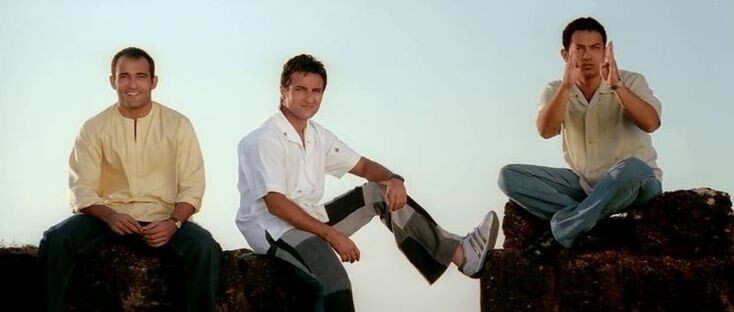In 2001, Dil Chahta Hai brought in a fresh perspective in Hindi cinema that diverged from the mainstream melodramatic and action-packed films that dominated the big screen during its time. Farhan Akhtar’s directorial debut was one of its kind. It followed three bachelors – Aakash (Aamir Khan), Sameer (Saif Ali Khan) and Siddharth (Akshaye Khanna) navigating the complexities of life that paved the way for fun and banter as well as a major fallout. While a few moments bend slightly towards the melodramatic, the film sets the benchmark for coming-of-age films that celebrate friendship in its finest light.
Hailed as a cult classic for its nostalgic appeal by millennials ever since its release, it is worth asking whether the film holds the same status amongst Gen Z or has time dimmed its charm?

Dil Chahta Hai (DCH) skipped the slow-motion running sequences in fields or gravity defying cars as well as the quintessential melodrama overload. Instead, we saw Goa trips, coffee shop conversations, graduation parties, beach sports and humour that gets one through heartbreak. This is where the film can also be interpreted as a post-modern piece. Post-modernism thrives on breaking established norms and DCH did the same with excluding the formulaic love triangles and one singular moral ending. It embraced the characters’ journey that was messy and unapologetically real.
It is impossible to not mention the film’s cultural successors – Ayan Mukerji’s Yeh Jawaani Hai Deewani and Zoya Akhtar’s Zindagi Na Milegi Dobara, which are much loved amongst today’s generation and rightfully so. But there sure are distinct ways in which DCH retains its individuality today, even after 24 years. Certain aspects of the film stay relevant to date, thanks to the universal themes. The three bachelors, fresh out of college are plunged into the pool of uncertainty with the crucial question of – What’s next? Something Gen Z can wholeheartedly relate to, whether we are job-hunting, switching jobs or planning a side hustle.
Javed Akhter’s Koi Kahe Kehta Rahe sung by Shaan, KK and Shankar Mahadevan, beautifully embodies the spirit of early adulthood. In fact, the first half of the film can be encompassed with this very song. The lyrics Bigade Duniya, Bigadne Bhi Do / Jhagade Duniya, Jhagadne Bhi Do / Lade Jo Duniya, Ladne Bhi Do, Hum Apni Dhun Mein Gaao exemplify the free-spirited nature of modern youngsters. It’s a refusal to conform and determination to live on their own terms.
And then there’s the Jahaaz metaphor at Chapora Fort – Sid pointing out a ship that will soon disappear over the horizon, just as friends eventually drift apart. It’s a foreshadowing of their fallout and eventual reunion, and a comforting reminder that real friends always show up and stay. In an era where ghosting is the norm, this sentiment still hits. And that is extremely comforting to realize in today’s technologically clogged reality.
We live in a world defined by hyperreality and hence the films’ ability to be detached from the material is refreshing. Although the youngsters may come from a wealthy background, the focus of the narrative is on the sentiments – Aakash, someone who goes from not believing in love to unexpectedly falling for Shalini (Preity Zinta), Sam and his multiple “I think I love her” ventures and Sid, with his complex yet mature understanding of his feelings for Tara (Dimple Kapadia). With our digitally driven lives, DCH offers good leeway to watch something relatable yet discrete.
Although some of the humour in DCH might feel very … 2001. Akash reducing Sid’s feelings for Tara to a crude MILF-driven feeling triggers their biggest fallout, a moment that makes us ponder upon the insensitivity and question whether the film will romanticize bromance above all. Thankfully, it doesn’t.
One poignant element the film beautifully encapsulates is having all three characters as equally important individual personalities – Aakash brings in the essential comic relief in the film be it the proposal scene or the speedboat scene where he jumps straight into the ocean to avoid being chased by Deepa, Sid, the quiet, introverted guy who expresses himself through his art, and Sameer offers goofy sensibility. Watching the boys evolve from being one call away at every minor inconvenience to hesitating before showing up for a friend at hospital but eventually giving in are the intricacies that friendship demands and a shift that one experiences in adult friendships – making the narrative even more relatable.
For a generation thriving on instant gratification and escapism, Dil Chahta Hai might not hold as a cult classic (no offense to millennials), but it still highlights friendship, love, and self-discovery in the most raw and real light, making it a perfect snug-in-bed one time watch even for Gen Zs.
Also read: Farhan Akhtar Posts Some Memorable Dialogues from Dil Chahta Hai


